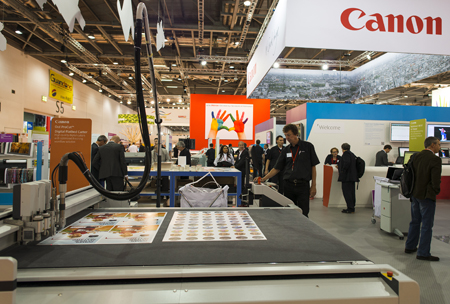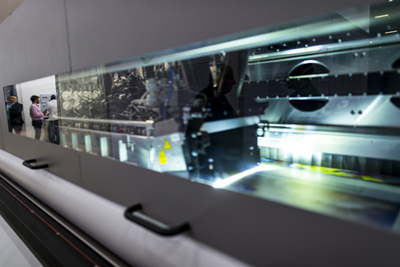Nessan Cleary flags up key areas of pre-investment discussion as trade show season gets underway.
There’s a number of trade shows over the coming few weeks, which of course we'll report on, and where there will undoubtedly be a lot of new/updated kit. But before we become too involved in looking at the new devices and their must-have features, we thought it time to consider the questions you should be asking before the 2014 investment cycle starts gathering momentum.
Obviously, you’ll think about the likely performance of any given machine and particularly the productivity, the image quality and the general build quality and reliability. Up until recently the market has been fairly polarised with most users having to choose between image quality and productivity, but we are increasingly seeing mid-range devices, such as the Durst P10 or Screen W3200, that are capable of producing good images, suitable for close up viewing, at high speeds. However, it’s worth considering whether one such production machine is better than two slower machines, which would take up double the space and require double the servicing, but offer some level of redundancy.
Peter Bray, sales manager for Durst UK, says: “The other criteria that customers always question is servicing and backup and the support network that we have in the UK as people are wary about having to go to central Europe for service.”
Most service contracts provide for an engineer to be on site within a day and the peace of mind from knowing this often justifies the cost. As vendors tend to offer different levels of service, depending on the parts that are also covered by the service contract, it’s worth going through the small print. Generally, the most expensive parts, and most likely to fail, are the printheads, but not all service contracts include this cost. It’s often hard to predict the average lifespan of a printhead (as good maintenance procedures can have such a marked effect) but it’s worth drilling down to find out what you can expect to spend over the expected use time of the printer.
Many vendors believe it’s no longer enough to simply sell a printer and leave the user to get on with it. For a while now there’s been a trend for manufacturers to encourage PSPs to think of them as business partners - if only because its easier to sell additional printers to successful print service providers.
Francois Martin, European marketing manager for HP, says that HP gives customers advice on their business model and how they can expect a new kit investment to impact upon that, adding: “They want to know the return on investment. For example, for vehicle graphics they want to know how many cars they need to decorate to break even.” The quality of the advice and data provided will vary from one vendor to the next, but is definitely something that should be put to the test as much as the actual prospective hardware purchase.
In recent years most inkjet manufacturers have become increasingly aware of the industrial manufacturing market and have spent a lot of time developing new ink formulations and applications to take advantage of this. Bray, for example, says that there are a number of interesting applications, noting that both the ceramic and glass markets are growing fast, with digital challenging screenprinting and gravure. He adds: “I think that packaging is very interesting for us as well. Also, we are looking at 3D printing.” But there are questions to be asked here.
Dominic Fahy of Canon reiterates that there's a balance between colour fidelity and ink adhesion, and that as printers explore more niche applications, there is a requirement to work with a broader range of substrates, some of which, such as Correx, can pose quite a challenge to ink adherence. Thus Canon offers two different ink sets, though most customers opt for the high colour fidelity. But as Fahy says, someone printing to a substrate like Correx doesn't necessarily need perfect skin tones but does need the ink to stick to the surface.
Canon provides application specialists to advise printers on how to deal with issues such as tricky substrates. Fahy explains: “We assign a technical application manager to the customer when they are looking at the machine to make sure that they can print the things they want to.” This specialist goes on to train the customers once the machine is installed and customers can go back to the specialist if they need further advice.
Canon has also noticed that printers are increasingly looking beyond display graphics to produce, for example, 500 school stationery sets, with each one having a different motif or some element of personalisation. Fahy adds: “The margins that printers can make from these applications are quite high so we see that as an accelerating trend in the market.” The bottom line – ask vendors what they can do to help you in terms of media/ink experimentation.
When it comes taking take advantage of personalisation it’s necessary to have both variable data software and some form of Web-to-print ordering system. Many printers would like to integrate MIS and workflow with their production, and although this software exists, most manufacturers agree that more needs to be done to integrate it better with the production hardware. Bray believes the industry is becoming more organised and that it's becoming easier for customers to fit all the different pieces together, from workflow to printer to finishing. But in reality most printer manufacturers rely on their Rip partners to integrate the various software elements.
Most PSPs simply use the Rip that comes with their printers, and rarely invest in an additional system so there’s little incentive for the Rip vendors to add extra features. That said, HP is now recommending the GMG ProductionSuite workflow for use with its wide-format printers, and Agfa has started shipping its Asanti workflow, which also includes the
Storefront Web-to-print system. Such systems take a lot of the headache out of managing software, where it can be hard to find one supplier to take charge of integrating the different systems together so it’s worth having a proper scout around and to ask just who’s doing what.
 Another important area to question manufacturers on is their environmental commitment. Many wide- format vendors have little to say on this subject - other than that their customers are not asking about it! But some of those same manufacturers also complain bitterly about HP's success in marketing its latex printers as a green solution to end customers, so much so that many design agencies now specify latex printing.
Another important area to question manufacturers on is their environmental commitment. Many wide- format vendors have little to say on this subject - other than that their customers are not asking about it! But some of those same manufacturers also complain bitterly about HP's success in marketing its latex printers as a green solution to end customers, so much so that many design agencies now specify latex printing.
At the very least you should ask any supplier about energy consumption, both in terms of the actual the printer and any associated processes, such as a heat press for dye-sublimation, since that will directly affect your day-to-day costs as well as your green credentials.
There's a growing number of recyclable substrates so its worth checking what media has been tested with any prospective printers, as well as the requirements for safe disposal of the inks.
Finally it's worth noting that there is a wealth of information on manufacturers and their products online, and also comment from existing users and industry commentators. Martin says that suppliers have to be on the ball as their customers can report problems widely to each other. He adds: “Also, customers can get answers on things like specialised substrates so they are helping each other quite a bit now.”
So will we see an increasing number of user groups, as is the case in commercial offset and small-format production digital printing? Such groups can play an important role, both in pushing R&D agendas and in filling in technical knowledge gaps.
{jathumbnail off}


